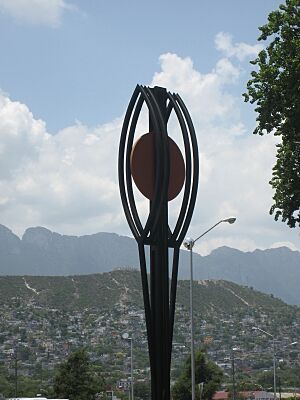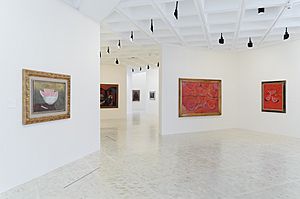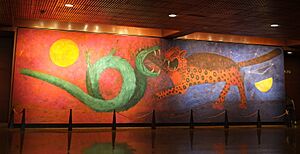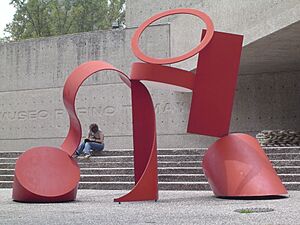Rufino Tamayo facts for kids
Quick facts for kids
Rufino Tamayo
|
|
|---|---|

Rufino Tamayo holding a guitar 1945,
Photo by Carl Van Vechten |
|
| Born |
Rufino del Carmen Arellanes Tamayo
25 August 1899 Oaxaca de Juárez, Mexico
|
| Died | 24 June 1991 (aged 91) Mexico City, Mexico
|
| Nationality | Mexican |
| Education | María Izquierdo, José Vasconcelos (National Archaeological Museum) |
| Known for | Painting and Drawing |
|
Notable work
|
Children Playing with Fire, Lion and Horse, Animals ,The Window |
| Movement | Modernism |
| Spouse(s) | Olga Flores |
| Elected | Head of the Department of Ethnographic Drawings, Escuela Nacional de Artes Plasticas, Universidad Nacional Autónoma de México |
Rufino del Carmen Arellanes Tamayo (born August 25, 1899 – died June 24, 1991) was a famous Mexican painter. He was from the Zapotec heritage, an Indigenous group in Mexico. Rufino Tamayo was born in Oaxaca de Juárez, Mexico.
Tamayo was very active in the middle of the 20th century. He created art in both Mexico and New York City. His paintings often showed real-life shapes mixed with abstract ideas. They also had influences from Surrealism, an art style that uses dream-like images.
Contents
Early Life and Art Beginnings
Rufino Tamayo was born in Oaxaca, Mexico, in 1899. His mother, Florentina Tamayo, was a seamstress, and his father, Manuel Arellanes, was a shoemaker. Sadly, his mother passed away in 1911 from tuberculosis. His Zapotec background was a big influence on his early art.
After his mother's death, Rufino moved to Mexico City to live with his aunt. He spent a lot of time helping her in the city's fruit markets.
In 1917, his aunt enrolled him in art school. It was called the Escuela Nacional de Artes Plásticas at San Carlos. As a student, he tried out different art styles. These included Cubism, Impressionism, and Fauvism. He gave these styles a unique Mexican feel. Tamayo later decided to study art on his own. In 1921, he started working for José Vasconcelos. He became the head of the Department of Ethnographic Drawings.
Rufino Tamayo's Art Career
Rufino Tamayo was one of Mexico's most important artists in the 20th century. Other famous Mexican muralists were Rivera, Orozco, and Siqueiros. After the Mexican Revolution, Tamayo wanted his art to have its own special identity. He focused on showing traditional Mexico. He did not like the strong political art that other artists created. He believed the revolution would harm Mexico, not help it.
In his painting, Niños Jugando con Fuego (Children Playing with Fire, 1947), Tamayo showed two people being burned. They were hurt by a fire they started themselves. This symbolized the Mexican people being hurt by their own choices. Tamayo said, "We are in a dangerous situation, and the danger is that man may be absorbed and destroyed by what he has created." Because of his views, some people called him a "traitor" to the political cause.
Moving to New York and Paris
Tamayo felt he could not express himself freely in Mexico. So, in 1926, he moved to New York City. Before leaving, he had a solo art show in Mexico City. People noticed his unique style. He returned to Mexico in 1929 for another show. This time, he received great praise and media attention.
Tamayo's art legacy includes his amazing graphic prints. He mastered many techniques for these prints. His graphic work, made between 1925 and 1991, included woodcuts, lithographs, and etchings. He also created "Mixografia" prints.
Developing Mixografia
With the help of Luis Remba, a Mexican printer, Tamayo invented Mixografia. This was a new way to make prints. It allowed for prints with three-dimensional textures. It could show the texture and depth of Tamayo's designs. It also let him use different materials in his art. Tamayo loved Mixografia and made about 80 original Mixographs. One famous one is Dos Personajes Atacados por Perros (Two Characters Attacked by Dogs).
In 1935, Tamayo joined the Liga de Escritores y Artistas Revolucionarios (LEAR). This group allowed Mexican artists to share their thoughts on the revolution. Even though Tamayo disagreed with some artists, he was chosen to represent Mexican art in New York. Rufino and his wife, Olga, planned to stay only for the event. But they ended up living in New York for 15 years.
In 1948, Tamayo had his first big art show in Mexico City. It was at the Palacio de Bellas Artes. Even though his political views were still debated, he was very popular. Feeling uncomfortable with the ongoing political arguments, Tamayo and Olga moved to Paris in 1949. They stayed there for ten years.
Tamayo also enjoyed painting women. He often painted his wife, Olga. He showed her struggles through his color choices and her facial expressions. Their shared difficulties can be seen in the painting Rufino and Olga (around 1934). In it, the couple looks broken by life's challenges.
Tamayo also painted large murals. Some are in the Palacio Nacional de Bellas Artes opera house in Mexico City. One famous mural is Nacimiento de la nacionalidad (Birth of the Nationality, 1952).
Rufino Tamayo also taught a few students privately. These included Francisco Toledo and Verónica Ruiz de Velasco. Both of them had their art shown in the National Museum of Modern Art.
Artistic Influences
Many artists and cultures influenced Tamayo. María Izquierdo, another Mexican artist, taught him about choosing colors carefully. He picked colors that truly represented his Mexican environment. He once said, "Mexicans are not a gay race but a tragic one..."
Tamayo's cultural background was another big influence. He was one of the few artists of his time who celebrated Mexico's different ethnic groups. He liked the mix of Spanish and Mexican-Indian heritage. This can be seen in some of his artworks. In Lion and Horse (1942), Tamayo used ideas from pre-Columbian ceramics. Tamayo was proud of his Mexican culture. He felt it nourished him, and traveling to other countries made him love Mexico even more.
Tamayo was very aware that Mexican artists were often ignored. This affected him deeply. For example, some people thought Tamayo's art "did not have much value." Many doubted that Mexican artists could create great art. During the Díaz government, Mexican artists were often overlooked. People commonly believed they were not as skilled as European artists.
Time Outside Mexico
From 1937 to 1949, Tamayo and his wife Olga lived in New York. He painted some of his most famous works during this time. His first show in New York City was at the Valentine Gallery. This helped him gain recognition. He then showed his art at the Knoedler Gallery and Marlborough Gallery. While in New York, Tamayo taught Helen Frankenthaler at the Dalton School.
Tamayo also visited important art exhibitions in the United States. These shows influenced his painting techniques. He saw works by artists like Ingres and Picasso. He also saw French art exhibitions. This introduced him to Impressionism, Fauvism, and Cubism. In 1928, at an exhibition in Brooklyn, Tamayo met Henri Matisse, a famous French artist.
In 1926, just one month after arriving in the United States, 39 of Tamayo's works were shown at the Weyhe Gallery in New York. This was a big difference from the few shows he had early in his career in Mexico. His time in New York greatly increased his fame. He became known not only in the United States but also in Mexico and other countries.
Art Style and Color Use
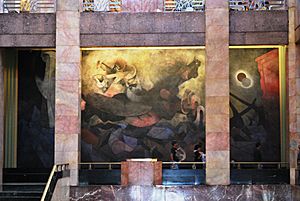
Tamayo explained his art approach to Paul Westheim. He said, "As the number of colors we use decreases, the wealth of possibilities increases." Tamayo preferred using fewer colors instead of many. He believed that fewer colors in a painting made the art stronger and more meaningful.
Tamayo's unique color choices are clear in his painting Tres personajes cantando (Three singers), from 1981. In this painting, he uses pure colors like red and purple. His careful use of color here shows his belief that fewer colors actually make the painting richer. Octavio Paz, who wrote a book about Rufino Tamayo, said, "Time and again we have been told that Tamayo is a great colourist; but it should be added that this richness of colour is the result of sobriety." By being "sober" with his color choices, Tamayo's paintings became richer, not poorer.
If I could express with a single word what it is that distinguishes Tamayo from other painters, I would say without a moment's hesitation: Sun. For the sun is in all his pictures, whether we see it or not.
Notable Artworks
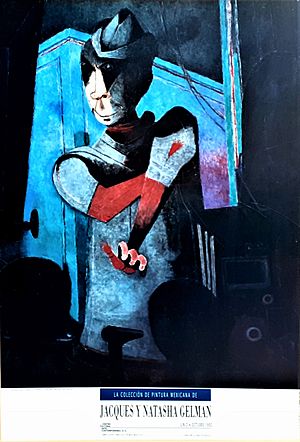
- Untitled (1926)
- Cabeza mujer (Woman's Head) (1927)
- Mujeres con rebozo (Women with Shawls) (1927)
- Still life with corn (1928)
- Naturaleza muerta con pie (Still Life with Foot) (1928)
- Still Life (1928)
- Interior with an alarm clock showing 4:47 PM on the night table (1928)
- Frutero Y Domino (Fruit Bowl and Domino) (1928)
- The Window(1932)
- Rufino and Olga (1934)
- Two Bathers (1934)
- Animals (1941)
- Lion and Horse (1942)
- Woman Spinning (1943)
- Children Playing with Fire (1947)
- Nacimiento de nuestra nacionalidad (Birth of Our Nationality) (1952)
- Mexico de Hoy (Mexico Today) (1953)
- El día y la noche (Day and Night) (1954)
- Naturaleza muerta (Still Life) (1954)
- America (1955)
- Matrimonio (Marriage) (1958)
- Retrato de niños (Pareja de niños) (Portrait of Children (Pair of Children)) (1966)
- El Perro en la Luna (The Dog on The Moon) (1973)
- Watermelons (1977)
- Tres personajes cantando (Three Singers) (1981)
- Hombre con flor (Man with Flower) (1989)
- Luna y Sol (Moon and Sun) (1990)
Return Home and Later Years
In 1959, Tamayo and his wife, Olga Flores, moved back to Mexico for good. Tamayo built an art museum in his hometown of Oaxaca. It is called the Museo Rufino Tamayo. In 1972, a documentary film was made about him. It was called Rufino Tamayo: The Sources of his Art.
The Tamayo Contemporary Art Museum (Museo Tamayo de Arte Contemporáneo) opened in 1981. It is located in Mexico City. This museum holds the art collection that Rufino Tamayo and his wife gathered. They later donated it to the country. Tamayo painted his very last painting in 1990, when he was 90 years old. It was called Luna y Sol (Moon and Sun).
Tamayo's art has been shown in museums all over the world. These include the Solomon R. Guggenheim Museum in New York City, and The Phillips Collection in Washington. His work is also in the Cleveland Museum of Art, the Naples Museum of Art, and the Oklahoma City Museum of Art. You can also find his art in The Museo Nacional Centro de Arte Reina Sofia in Madrid, Spain.
Death
On June 12, 1991, Tamayo was admitted to a hospital in Mexico City. He had problems with his breathing and heart. He suffered a heart attack and passed away on June 24, 1991.
Even in his later years, Tamayo continued to create art. He was very productive during that time. Several important exhibitions and books were made about his work after he died.
Theft and Recovery of a Painting
Tamayo's 1970 painting Tres Personajes was bought by a man in Houston in 1977. It was a gift for his wife. But in 1987, the painting was stolen from their storage unit during a move.
In 2003, a woman named Elizabeth Gibson found the painting. It was in the trash on a New York City street. She didn't know much about modern art. But she felt the painting "had power." She took it without knowing where it came from or how much it was worth. She spent four years trying to learn about the artwork. She eventually found out from the PBS website that it had been on an episode of Antiques Roadshow.
After seeing the "Missing Masterpieces" part about Tres Personajes, Gibson and the painting's original owner worked together. They arranged to sell the painting at a Sotheby's auction. In November 2007, Elizabeth Gibson received a $15,000 reward. She also got a part of the $1,049,000 sale price from the auction.
Awards and Recognitions
Rufino Tamayo received many important awards for his art:
- National Prize for Arts and Sciences in Fine Arts of Mexico, 1964
- Honorary Doctor by the National University of Mexico, 1978
- Honorary Doctor of Fine Arts by the University of Southern California, 1985
- Gold Medal of Merit in the Fine Arts of Spain, 1985
- Belisario Domínguez Medal of Honor by the Mexican Senate, 1988
- Grand Officer of the Order of Merit of the Italian Republic, 1989
- Honorary member of the National College of Mexico, 1991
Exhibitions and Retrospectives
- Tamayo: The New York Years, Smithsonian American Art Museum 2017–2018
See also
 In Spanish: Rufino Tamayo para niños
In Spanish: Rufino Tamayo para niños
- Acapantzingo, Cuernavaca
- List of people from Morelos, Mexico
- Museo Rufino Tamayo, Mexico City
- Museo Rufino Tamayo, Oaxaca


